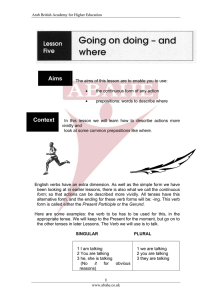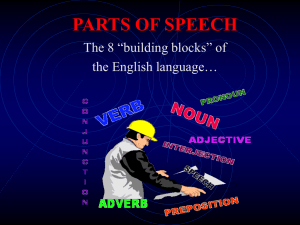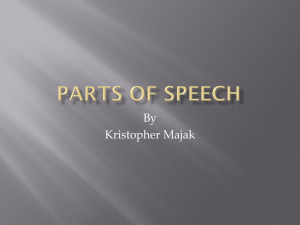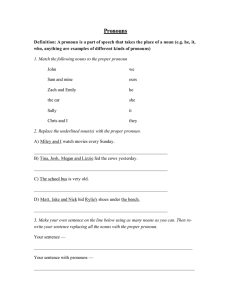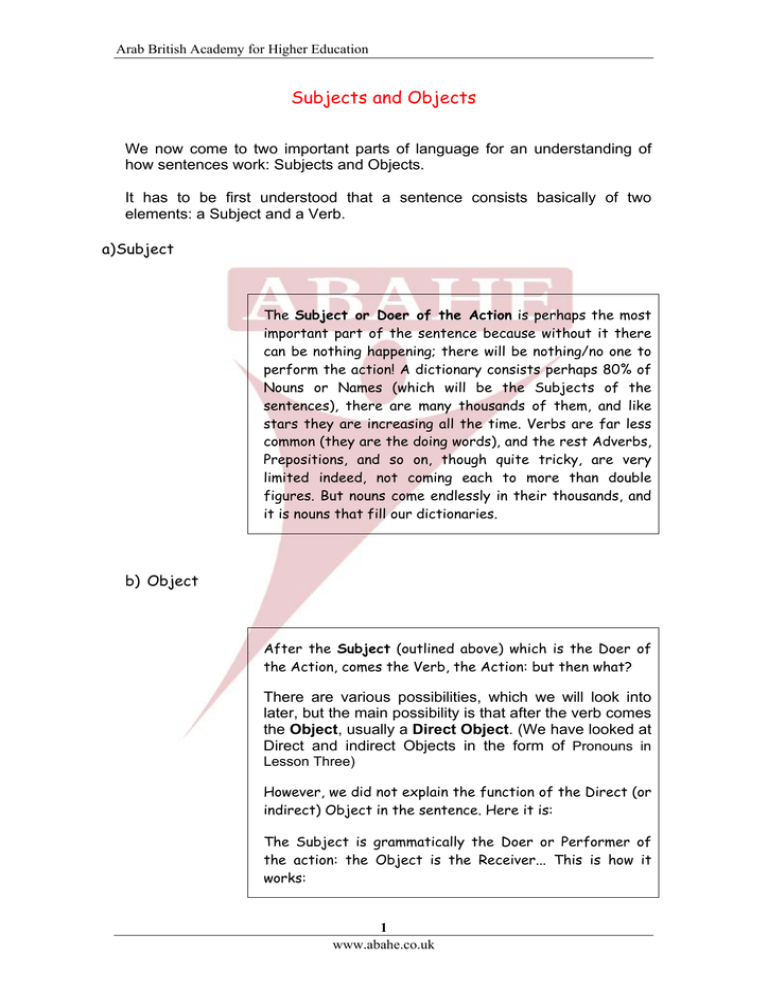
Arab British Academy for Higher Education
Subjects and Objects
We now come to two important parts of language for an understanding of
how sentences work: Subjects and Objects.
It has to be first understood that a sentence consists basically of two
elements: a Subject and a Verb.
a) Subject
The Subject or Doer of the Action is perhaps the most
important part of the sentence because without it there
can be nothing happening; there will be nothing/no one to
perform the action! A dictionary consists perhaps 80% of
Nouns or Names (which will be the Subjects of the
sentences), there are many thousands of them, and like
stars they are increasing all the time. Verbs are far less
common (they are the doing words), and the rest Adverbs,
Prepositions, and so on, though quite tricky, are very
limited indeed, not coming each to more than double
figures. But nouns come endlessly in their thousands, and
it is nouns that fill our dictionaries.
b) Object
After the Subject (outlined above) which is the Doer of
the Action, comes the Verb, the Action: but then what?
There are various possibilities, which we will look into
later, but the main possibility is that after the verb comes
the Object, usually a Direct Object. (We have looked at
Direct and indirect Objects in the form of Pronouns in
Lesson Three)
However, we did not explain the function of the Direct (or
indirect) Object in the sentence. Here it is:
The Subject is grammatically the Doer or Performer of
the action: the Object is the Receiver... This is how it
works:
1
www.abahe.co.uk
Arab British Academy for Higher Education
Example
I catch the ball
I (Subject = Doer of the Action) catch (Verb) the ball (Object = Receiver of the
Action)
We see the church
We (Subject) see (Verb) the Church (Object)
What we have been describing have been Direct Objects,
but we will have a look at indirect Objects in the next
Lesson.
Why we have studied them is that as we saw in the
previous Lesson (Twelve), one can get very confused,
especially when looking at Relative
Pronouns for example if we do not know the difference
between Subject
and Object. See below for examples.
Example
a)
The ball (that) I can see is on the table.
You will see the Relative Pronoun that is in brackets which
means it can be left out without altering the meaning of
the sentence: this can only be done if the Relative Pronoun
is the Direct Object of the Clause: it has to be, because I
is the Subject, see below:
Main Clause: = The ball (Subject) is on the table
Subordinate Clause = that (Direct Object) I can see
i.e. I can see the ball (Direct Object) that is on the table
n.b. that is on the table simply says more about, or in a sense describes:
ball...
b) The man on the pavement is the one (that) I do not trust
Note: that (in brackets) is a Relative Pronoun and the Direct Object of the
Verb ‘I do not trust...’; it can be omitted, thus:
The man on the pavement is the one I do not trust
I hope this is not too complicated. This is all very involved,
2
www.abahe.co.uk
Arab British Academy for Higher Education
but in the end practice makes perfect, and you will see
soon how all this does make sense. Language, one has to
recognise, is never easy.
Now we come to Activity Two: this sums up what you have learnt about
Direct Objects and Relative Pronouns:
Activity 2
Join the following sentences and include that, who or which
where necessary: put a bracket around it if if can be left out:
e.g. This is the one (that) I have been looking for
) The table is laid with plates and dishes. It has a blue table
cloth.
b) My dog has run away. He is very friendly.
) Mary was wearing a bright red dress. She had bought it that
afternoon.
d) Those thatched cottages are beautiful. They are historic
monuments.
e) The station is very busy. It is in the centre of town.
) There are books in my case. They are all novels.
) Paul is walking to the coast. He is a young lad of about
seventeen.
h) I
can see many children. They are all playing football in the
park.
All Rights Reserved © Arab British Academy for Higher Education
3
www.abahe.co.uk

